You are probably reading this article hoping for straightforward answers on homeschooling cost. And maybe if you read other answers from Google you’ll find those. But as a homeschooling parent of more than 10 years, I have to say there is not an easy answer to how much it costs to homeschool.
So while I could stick out some number or price range like many do, I hope you will continue reading to find out more to the topic than just a price range.
In this article, I will discuss not only the basic and obvious costs of homeschooling, but also more hidden expenses. I will also get into more figurative and non-monetary expenses of homeschooling. I will be giving very frank answers from my experience as well.
Let’s get started.
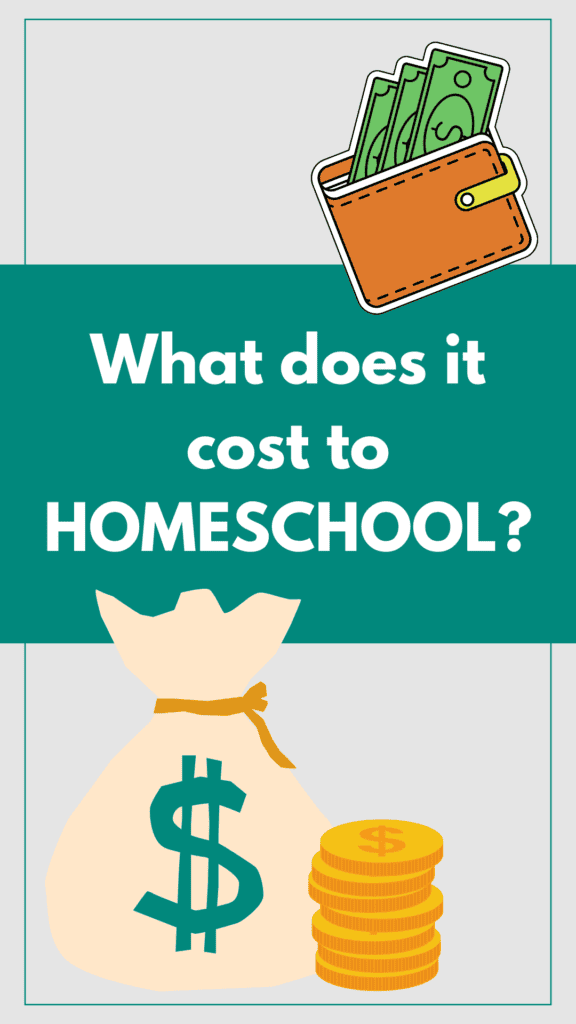
What others say
You will hear a range of ideas of what homeschooling costs when you start asking around. Some will say you can homeschool for free, while others will say they pay thousands per year to homeschool. The cost is as individual as the family.
One popular homeschool site states homeschooling costs on average between $700-1800 per child per year! This is broken down to not only curriculum, but other supplies, classes, and field trips. And this is the truth. There are so many variables to consider in homeschool expenses.
You may not spend much on curriculum, but what about all the other costs? While others may spend a lot on curriculum and very little on field trips and activities.
In fact, the National Home Education Research Institute (NHERI) states that homeschool families spend around $600 annually per child on homeschool related expenses. When compared to the average of more than $16,000 spent per child by the US Government for children in public schools, this expense doesn’t seem too big of a deal.
So let’s take a deeper look at some of these expenses.

Basic cost of homeschooling
Let’s take a look at the obvious and basic costs of homeschooling. This is the curriculum, supplies, field trips, and activities of homeschooling. The NHERI states that on average, homeschool families spend about $600 annually per child. Just like with any other household expense, families can easily spend less or more depending on many factors. Let’s take a look at each.

Less obvious homeschooling costs
When most people think about the cost of homeschooling, they will think about curriculum. This can absolutely be free. But even for homeschoolers who use free curriculum, there are often many other expenses that are less obvious. But these added expenses should absolutely be considered as well.
Here are a few hidden costs of homeschooling to consider:

Options that affect price
Not every family wants the same things for their children. Just like in every other parenting and household decision, we have choices that may be expensive or not. Many families are forced into shopping at thrift stores and foregoing dance lessons. The same applies to homeschooling. The choices that affect the cost are largely up to you and your finances. You can choose to spend less on homeschooling or not.
And to take this one step further, there may be ways your family can lower their cost of living to accomodate the cost of homeschooling. Many homeschool families I know have one household income, allowing one parent to stay and teach the kids. They may live in a small house. Many of these families are not wealthy or privileged, but make this decision because homeschooling is more important to their family than the other options.
Another big factor is the personality of those in the family. Extroverted families will want and need more time with others. This can be done on the cheap, but often social gatherings and classes can be costly. Even cheap options will add up quickly.
Why is there such a big range for the cost of homeschooling? Because not everyone chooses the same curriculum, approach, classes, activities, lifestyle, or anything else associated with homeschooling.
Here are some choices to consider that may largely affect your homeschooling cost.
- Online classes or textbooks
- Multiple kids or one child
- New curriculum or used
- Purchased curriculum or DIY
- Hands on learning or reading books
- Social or introverted
- Buy books or use the library
- Dance lessons or not
- League sports or PE at home
- Private lessons or YouTube
- In-person classes or learning at home
- Buy new for each child or re-use curriculum
- Money or time

Opportunity cost of homeschooling
You can’t talk about the cost of homeschooling without acknowledging oportunity cost. This is the cost associated with lost opportunity. In this case, it’s choosing homeschooling over another option – the things you are “missing out on” by homeschooling. Monetarily, this includes lost income for a parent. In other aspects it includes the missed opportunity of music and art classes, or some would say the loss of potential college options.
Some of these opportunity costs are real and others are not. Still others you may be able to find an alternative option.
A very big opportunity cost many can’t overlook is the loss of one parent’s income. While this is difficult it can be dealt with. Either through lowering your family’s cost of living to offset it, or by finding a more flexible work opportunity. Of course, parents must also understand that homeschooling does not require teaching from 9-3 every day.
I personally know several homeschooling parents who either work from home or have a job that allows them to continue homeschooling. Either by bringing their kids with them to work, or by having a flexible schedule that allows for both. Homeschooling during the day and working at night, or vice versa.
Many suggest that homeschooling doesn’t give you the same opportunities for colleges, and that couldn’t be further from the truth. Most colleges have no problem accepting homeshcooled students, even with homemade transcripts! There are many students who are even recruited and accepted into Ivy League and military schools without a problem.
Homeschooled students will have to meet the same requirements as any student. Excel in learning, do well on tests, take competitive class options, volunteer, and be a part of skill-building organizations. While it may be more difficult as the parent is the guidance counsler, it absolutely can be done and there are many resources for homeschool parents to learn about these things online.
Another “loss” to be considered for homeschoolers is the opportunity to take part in school dances, graduations, sporting events, the arts, competitions, clubs, and even AP classes. While these things will matter more to some than others, not attending public school does not always mean you will not be able participate in these things.
Many areas have started organizing homeschool dances and graduations. There are many sports and art organizations that not only allow homeschoolers to take part, but some are designed just for homeschoolers. Homeschoolers can participate in things like robotics competitions, spelling bees, and math club as well. It just takes someone to head up the group.
There are also many states that allow students to participate in public school sports, arts, and clubs. Often the student will be required to take at least one class at the school, but the requirements depend on the state law. Homeschoolers are also able to take AP exams as well as the PSAT/NMSQT through their local school system.
This is difficult, but as homeschooling continues to grow, I believe most of these “costs” will be a thing of the past. Opportunities for homeschoolers will only grow.

Time or Money?
They say that time is money, and for much of the cost of homeschooling, this definitely applies. It is often true that if parents spend a little more of their time and effort on homeschooling, they can get a similar result as one of the more expensive homeschool programs without the added financial cost.
For instance, you can buy an all-in-one curriculum box with all the plans and reading books included. Or you could just buy the main textbooks and the plans, then source your own readers from the library to save money. You could even just buy the textbooks and design your own plans if you want as well. But sourcing library books and designing the plans takes time. It’s a tradeoff.
You can:
- buy a planner for $35 or DIY your own.
- pay to be a part of a group and go along with others’ field trips or plan your own.
- clean your own house or pay someone else.
- plan your menu and grocery shop or pay for a meal service.
- keep your own records and grade papers or pay for a service.
- teach your child math or pay for an online course.
Money or time.
If you have the expertise in a subject or are willing to put in the time to learn, then many costs of homeschooling could be lowered. But it is a trade-off. It’s not always money or time, sometimes it’s money or sanity. 🤪 But it will always be a trade off.

Non-monetary cost of homeschooling
Beyond the actual financial expenses of homeschooling are the non-financial costs. These also can be extensive and will be different for each family. Things many families feel are a cost of homeschooling have much to do with the affect on the parents. Homeschooling your kids takes time and energy, creates a messy house, and can leave little time for parents to have time to themselves.
Many moms choose homeschooling because they love their children, want what they feel is best for them at the time, and want to see them learn and grow. There is always a trade-off. Your kids are always with you ❤️, but….your kids are always with you! 🥴
Being with your kids all the time can be draining. It can make it more difficult for you mentally and will make it difficult to pursue your own desires and goals.
Because kids are home all day, there is likely to be more cooking and cleaning needed. You will not be able to just run to the store or get your nails done without first gettin your kids settled with a sitter. Until they are old enough to be on their own, of course.
The mental strain of being a stay at home parent can be difficult for many. And this keeps many families from homeschooling.
I even hear of many parents not understanding how anyone would even want to be at home with their kids since kids are awful. Well, to be honest, that sounds like a parenting problem. Not a homeschooling or a patience problem. Just to be real.
On the flip side, being with your kids can be very rewarding for your family bonding. Teaching your children your family values and encouraging them to be who they are made to be. Watching them learn and grow. Creating amazing memories and experiencing life together.
These are all best done by the people who love them most. The people who care for them more than anyone else possibly could. By their parents.
Then to add that homeschooling also gives you so much more! The flexibility of schedules, the ability to travel, learn whatever, whenever, and wherever you desire, choice over learning topics, ability to follow interests and abilities, controlling influence, and going at your own pace. There is all of this and more that you gain by homeschooling.
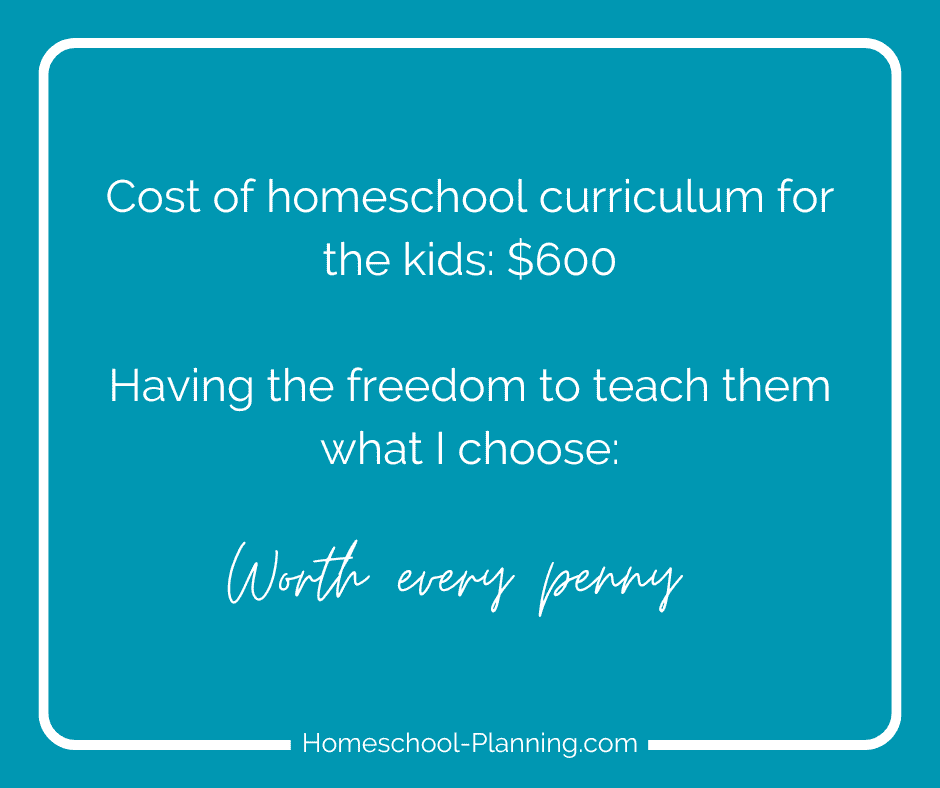
Weighing the trade-offs
So how do you decide if the cost is worth it for homeschooling? This typically requires weighing the trade-offs. Much of the cost of homeschooling is financial, where most of the gain is non-financial. There is always a trade. Which wins out for your family?
- Individualized education or $500?
- A few days to plan your year or the joy of seeing your children learn to read?
- Not getting a lot of space to yourself or school dances?
These are extreme oppositions just to bring home the point. So much of the time, we look at just the cost to our pocketbook when maybe we should be looking at a bigger picture.
Of course, I am by no means saying that parents who choose public or private schools are terrible parents and are missing out on everything in their children’s lives. I am also not saying everyone can or should homeschool. I am just making sure that if the cost is a big factor in your decision, that you will truly look at the full picture of what you gain and what you lose.
This reminds me of those old Mastercard commercials. They would list the cost of several things. Then at the end, they’d list something that is more emotionally rewarding and say it’s ‘priceless.’ “There are some things money can’t buy. For everything else, there’s Mastercard.”
This couldn’t be more true with homeschooling. Homeschooling will cost you money. But what you gain is priceless.
You list out all the cost, but only you can decide if it outweighs what you will gain.
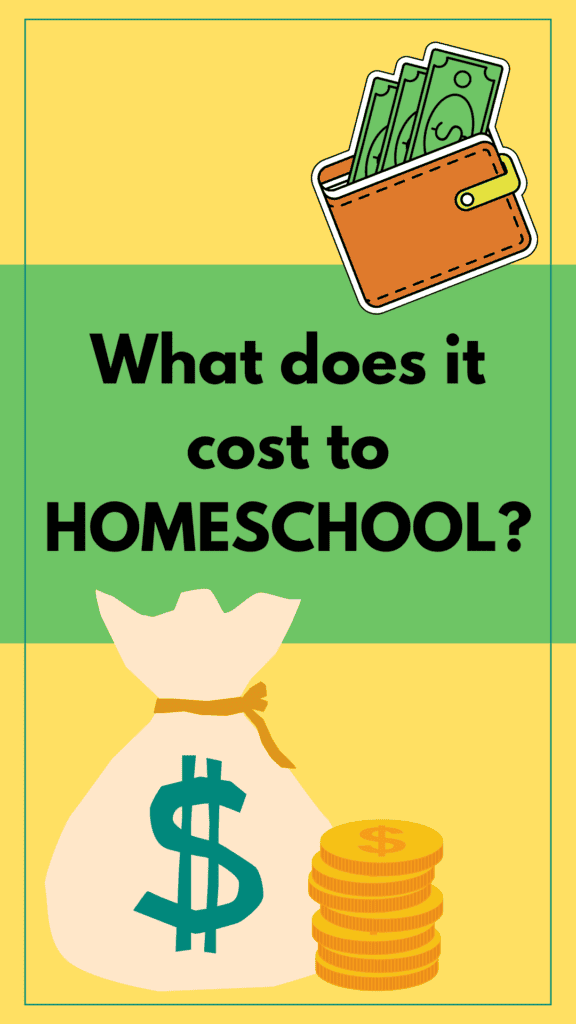
Compare to public and private options
Don’t forget that despite public schools being “free” in the US, there are often additional costs not covered. Not to mention the fact that homeowners pay toward local public schools whether they use them or not!
Here are some of the extra fees you may encounter in a public school:
- School supplies
- Uniforms
- Books
- Subscriptions
- Computer
- Club cost
- School spirit activities
- Costumes
- Buying books at the book fair
- PTA activities
- Booster club activities
- Sports fees, uniforms, etc.
- Attending sporting events
- Parent volunteer time
- Field trips
- Treats and snacks
- Lunches
- Extra project supplies (science fair, etc.)

Ways to lower homeschooling costs
If money is an issue for your family, what are some ways to lower the financial burden for your family? Buying used curriculum, using library books, keeping your own grades and records, and getting homeschool discounts are just a place to start. Any way you can trade your time instead of spending money will help lower costs.
Here are some more ideas:
- Re-use curriculum with other kids
- Use the library
- Find cheap or free curriculum
- Take advantage of cheap or free programs
- Wait for sales
- Buy used curriculum
- Borrow resources from a friend
- Research for homeschool discounts
- Use library passes to museums
- DIY a planner
- Use spreadsheets for grade keeping
- Create a homeschool group that’s free in your area
- Don’t use consumable workbooks
- Visit state parks for field trips instead of expensive museums
- Stay away from subscription fees
- Participate in a co-op instead of a tutorial or hybrid
- Create your own curriculum
- Do school projects and experiments with friends to reduce cost
- Exercise at home instead of participating in group sports
- Research curriculum options so you reduce chances of choosing poorly
- Use curriculum that is good for teaching your kids together.
- Re-sell curriculum you are finished with to offset cost
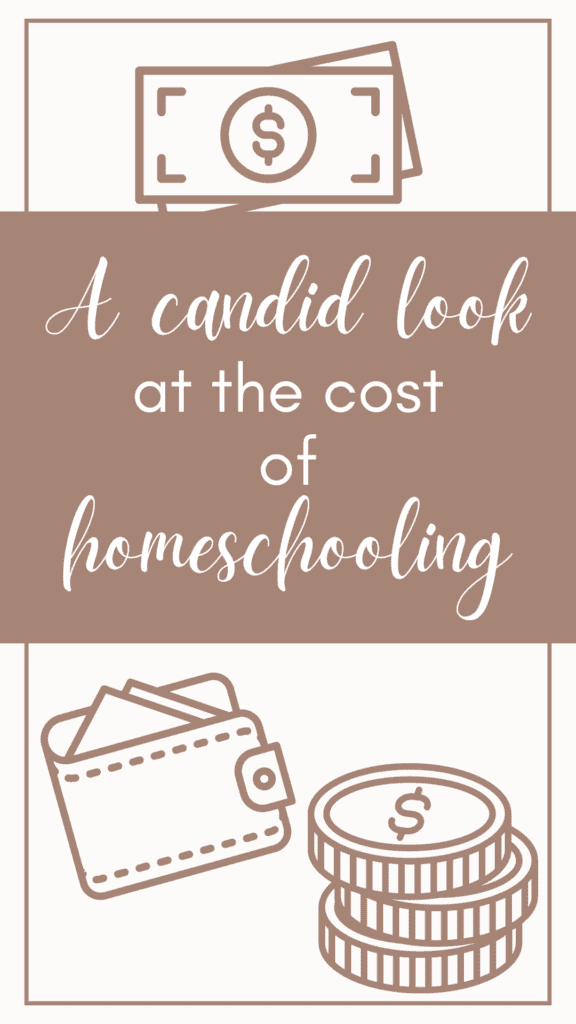
My family’s experience
My husband and I were both homeschooled, so homeschooling was a fairly natural idea for our family to consider. I have stayed home with our kids since they were born. Despite having a bachelors degree, it is not in a field that would make me much money, so it has never felt like working out of the home would be worth leaving my kids.
With that said, when our oldest got old enough to begin school, my husband was in nursing school on top of being a sub-contractor in the construction field. We made very little money, did not live in a very good area, or have a nice house. But we believed in my being home with our kids and teaching them so much that I continued.
I spent a lot of time researching curriculum, buying it used, and sourcing books from the library. We were given a lot by others, including curriculum. We rarely did any field trips that cost money, and participated in a low-cost soccer league. We tried a few low cost homeschool groups here and there. We also did some subjects with friends when we could work it out.
I used a lot of printable resources with my littles and made some educational manipulatives for them as well. I printed out free planning pages to manage our homeschool and records. I cut every corner I could and spent a lot of time and energy doing it all.
We also were a part of a homeschool umbrella for our legal and record-keeping needs.
We likely spent $300 a year on the high end to homeschool in the beginning. This included the sports and things we may have done whether or not we were homeschooling.
As my kids got older and I began homeschooling more than one, I began re-using curriculum with my younger kids. But as my son got older, curriculum got a little more expensive. I was also schooling more kids.
By this time, my husband had graduated college and was working full-time in a much more stable career. I could be a little more choosy and had some freedom to spend a little more on curriculum if I wanted.
But most years, I still have not spent a ton on curriculum. I bought curriculum for this school year a few weeks back and spent $4-500 total. In the past, I know I have spent more, upwards of $800 some years. For all 3 of my kids.
Do understand, though, that I am not buying a lot of new things for my younger two. We re-use quite a bit of curriculum. And I try to buy whatever I can used. This is the first year we have used a paid online program for any subject. We have always used regular books.
If I were buying everything new for all of my kids this year, it would likely have been double the cost.
I still tend to be frugal in our homeschooling efforts whenever possible. We use our library regularly, borrow any books we can, and attend only cheap or free field trips and social events. Though we have participated in a co-op for the past 3 years or so, which is fairly low cost. It is around $200 a year for our family.
One thing I do spend money on every year is a planner. It is an expense that is worth it for me. However, this year, I have made my own! (You can use it too!)
I also use spreadsheets to keep grades and records in addition to my own record-keeping and attendance printables.
We do not currently have the extra resources to spend on extra-curricular classes like music, dance or sports, so we just try to be active with friends, go to the park, play at the pool, and ride bikes and such. I am giving my daughter informal piano lessons myself.
I now have a certification that could make more money than when my kids were young. But when given the opportunity to go to work, I still felt that the added income was not worth the expense of leaving my kids at the time. This may change in the future.
I do try to take it one year at a time with homeschooling. We discuss every so often whether or not we want to continue homeschooling. My husband has always made sure it was truly up to me, trying not to pressure me in either direction. I am grateful for this.
For now and the foreseeable future, homeschooling is what we will be doing and is worth every penny. The time with my kids, the joy of seeing them learn and grow, being able to create individualized learning plans for each of my children, being able to monitor and shape what my kids are learning, and the flexibility of our schedules is all worth the cost from every angle.
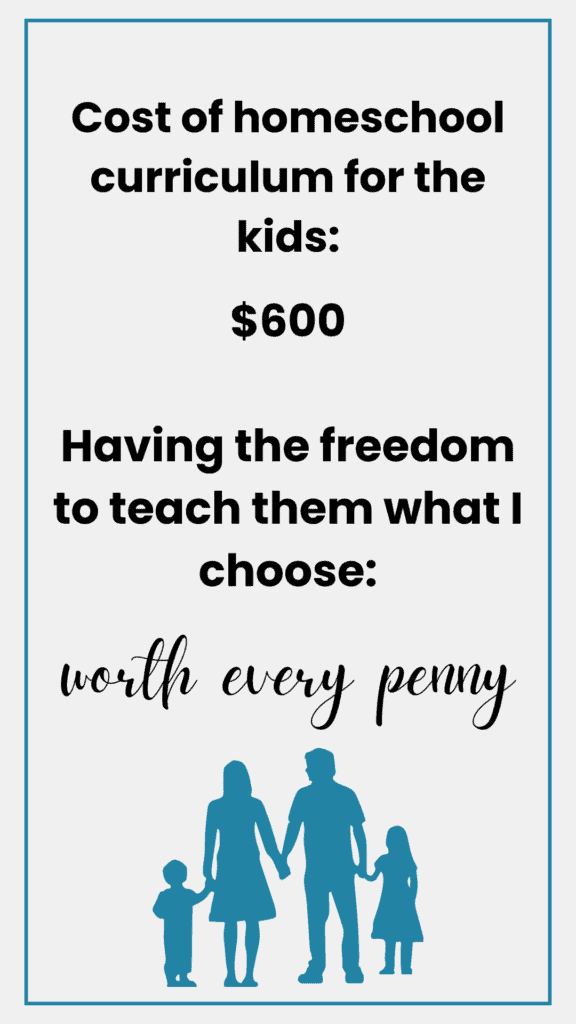
FAQ
The bottom line
The cost of homeschooling seems to average somewhere around $600 annualy per child, but can easily vary within a large range, from less than $100 to more than $2,000 per child. There are many options to make homeschooling low cost, so the true cost of homeschooling is largely up to the family’s choices regarding things like curriculum, supplies, and activities. If parents are willing to put in effort, this trade-off will help with expenses. But ultimately, for most homeschool parents, the benefits of seeing their children learn and grow greatly outweighs any monetary expense.



